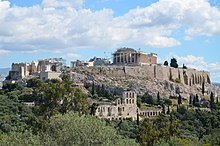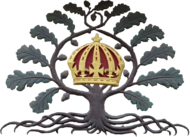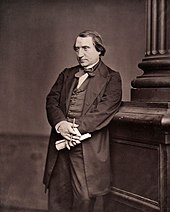High culture

In a society, high culture encompasses cultural objects of aesthetic value, which a society collectively esteems as being exemplary works of art,[1] and the intellectual works of literature and music, history and philosophy, which a society considers representative of their culture.[2]
In popular usage, the term high culture identifies the culture either of the
though very often also enjoyed by the upper classes.
In Notes Towards the Definition of Culture (1948), T. S. Eliot said that high culture and popular culture are necessary and complementary parts of the culture of a society. In The Uses of Literacy (1957), Richard Hoggart presents the sociologic experience of the working-class man and woman in acquiring the cultural literacy, at university, which facilitates social upward mobility. In the U.S., Harold Bloom and F. R. Leavis pursued the definition of high culture, by way of the Western canon of literature. Media theorist Steven Johnson writes that, unlike popular culture, "the classics—and soon to be classics—are in their own right descriptions and explanations of the cultural systems that produced them." He says that "a crucial way in which mass culture differs from high art" is that individual works of mass culture are less interesting than the broader cultural trends which produced them.[6]
History in the West

The high culture of the
From the idea of the "free" man with sufficient leisure to pursue such intellectual and aesthetic refinement, arose the classical distinction between the "liberal" arts which are intellectual and done for their own sake, as against the "servile" or "mechanical" arts which were associated with manual labor and done to earn a living.[9] This implied an association between high culture and the upper classes whose inherited wealth provided such time for intellectual cultivation. The leisured gentleman not weighed down by the necessity of earning a living, was free to devote himself to activities proper to such a "free man"[10] – those deemed to involve true excellence and nobility as opposed to mere utility.
During the Renaissance, the classical intellectual values of the fully rediscovered Græco–Roman culture were the cultural capital of the upper classes (and the aspiring), and aimed at the complete development of human intellectual, aesthetic, and moral faculties. This ideal associated with humanism (a later term derived from the humanities or studia humanitatis), was communicated in
The evolution of the concept of high culture initially was defined in educational terms largely as critical study and knowledge of the Græco–Roman arts and
Cultural traditions
In the Western and some
Cultural capital

| Part of the Politics series on |
| Toryism |
|---|
 |
In socially-stratified Europe and the Americas, a first-hand immersion to the high culture of the West, the Grand Tour of Europe, was a rite of passage that complemented and completed the book education of a gentleman, from the nobility, the aristocracy, and the bourgeoisie, with a worldly perspective of society and civilisation. The post-university tour of the cultural centres of Europe was a social-class benefit of the cultural capital transmitted through the high-status institutions (schools, academies, universities) meant to produce the ideal gentleman of that society.
The European concept of high culture included cultivation of refined etiquette and manners; the education of taste in the fine arts such as sculpture and painting; an appreciation of classical music and opera in its diverse history and myriad forms; knowledge of the humane letters (literae humaniores) represented by the best
High art

Much of high culture consists of the appreciation of what is sometimes called "high art". This term is rather broader than Arnold's definition and besides
The cultural products most often regarded as forming part of high culture are most likely to have been produced during periods of high civilization, for which a large, sophisticated, and wealthy urban-based society provides a coherent and conscious aesthetic framework, and a large-scale milieu of training, and, for the visual arts, sourcing materials and financing work. Such an environment enables artists, as near as possible, to realize their creative potential with as few as possible practical and technical constraints, though many more could be found on the cultural and economic side. Although the Western concept of high culture concentrates on the Greco-Roman tradition, and its resumption from the Renaissance onwards, such conditions existed in other places at other times.
Art music
Art film
Art film is the result of filmmaking which is typically a serious, independent film aimed at a niche market rather than a mass market audience.[17] Film critics and film studies scholars typically define an "art film" using a "...canon of films and those formal qualities that mark them as different from mainstream Hollywood films",[18] which includes, among other elements: a social realism style; an emphasis on the authorial expressivity of the director or writer; and a focus on the thoughts and dreams of characters, rather than presenting a clear, goal-driven story. According to the film scholar David Bordwell, "art cinema itself is a film genre, with its own distinct conventions."[19]
Promotion
The term has always been susceptible to attack for
With the widening of access to university education, the effort spread there, and all aspects of high culture became the objects of academic study, which with the exception of the
Especially in Europe, governments have been prepared to subsidize high culture through the funding of museums, opera and ballet companies, orchestras, cinema, public broadcasting stations such as BBC Radio 3, ARTE, and in other ways. Organizations such as the Arts Council of Great Britain, and in most European countries, whole ministries administer these programs. This includes the subsidy of new works by composers, writers and artists. There are also many private philanthropic sources of funding, which are especially important in the US, where the federally funded Corporation for Public Broadcasting also funds broadcasting. These may be seen as part of the broader concept of official culture, although often a mass audience is not the intended market.
The New York Times "Arts & Leisure" section, from 1962 to 1988, featured articles on high culture which usually outranked popular culture. But by 1993, articles on pop culture (49%) soon outranked the ones on high culture (39%) thanks to advertising effecting editorial coverage (mostly on the latest motion pictures).[21] Advertising on literature, however, has been prominent since the novel became a popular literary genre in the 19th century. Authors like Charles Dickens, Henry James and James Joyce worked in advertisement before their literary careers and/or had used ads on their novels.[22]
Theories

The relations between high culture and mass culture are concerns of cultural studies, media studies, critical theory, sociology, Postmodernism and Marxist philosophy. In the essay "The Work of Art in the Age of Mechanical Reproduction" (1936), Walter Benjamin explored the relations of value of the arts (high and mass) when subjected to industrial reproduction. The critical theoreticians Theodor W. Adorno and Antonio Gramsci interpreted the high-art and mass-art cultural relations as an instrument of social control, with which the ruling class maintain their cultural hegemony upon society.[23]
For the Orientalist Ernest Renan and for the rationalist philosopher Ernest Gellner, high culture was conceptually integral to the politics and ideology of nationalism, as a requisite part of a healthy national identity. Gellner expanded the conceptual scope of the phrase in Nations and Nationalism (1983) stating that high art is "a literate, codified culture, which permits context-free communication" among cultures.
In
See also
- Achieved status
- Bildung
- Bildungsbürgertum
- Culturology
- General knowledge
- High society
- Oswald Spengler
- High:
- Non-high:
- Middlebrow
- Working class culture
References
Citations
- ^ Williams, Raymond. Keywords: A Vocabulary of Culture and Society (1983) Rev. Ed. p. 92.
- ^ Williams, Raymond. Keywords: A Vocabulary of Culture and Society (1983) Rev. Ed. p. 91–92.
- ISBN 978-0-415-03767-9.
- ^ Arnold, Matthew (1869). Culture and Anarchy. The Cornhill Magazine.
- (2003) Culture and Anarchy at Project Gutenberg
- ^ The Encyclopedia of Philosophy (1967) Volume 1. p. 167.
- ISBN 978-0-14-193312-2.
- ^ Gellius · Attic Nights — Book XIII
- ^ M. Tullius Cicero, De Officiis, Book I: Moral Goodness, section 150
- ^ "Jacques Maritain Center: Art and Scholasticism 4". maritain.nd.edu. Archived from the original on 2021-02-27. Retrieved 2017-12-26.
- ^ Seneca. "Moral letters to Lucilius" – via Wikisource.
- ISBN 0719046181, 9780719046186, google books
- ^ a b "Music" in Encyclopedia Americana, reprint 1993, p. 647
- ^ a b
Denis Arnold, "Art Music, Art Song", in The New Oxford Companion to Music, Volume 1: A-J, (Oxford and New York: Oxford University Press, 1983): 111. ISBN 0-19-311316-3
- ^ Philip Tagg, "Analysing Popular Music: Theory, Method and Practice", Popular Music 2 (1982): 41.
- ^ "Music" in Encyclopedia Americana, reprint 1993, p. 647
- ^ Philip Tagg, "Analysing Popular Music: Theory, Method and Practice", Popular Music 2 (1982): 37–67, here 41–42.
- ^ Art film definition – Dictionary – MSN Encarta. Archived from the original on 2009-08-30.
- ^ Barbara Wilinsky. Sure Seaters: The Emergence of Art House Cinema at Google Books. University of Minnesota, 2001 (Commerce and Mass Culture Series).
- ^ Keith, Barry. Film Genres: From Iconography to Ideology. Wallflower Press: 2007. (page 1)
- ^ Promoting high culture: The evolution of the Brisbane Musical Union, 1872–98|Queensland Review|Cambridge Cove
- ^ The Competition between High Culture and Popular Culture as Seen in the "New York Times" on JSTOR
- ^ Project MUSE - High Culture/Low Culture: Advertising in Literature, Art, Film, and Popular Culture
- ISBN 978-0-14-008227-2.
Élite culture is often an instrument of social control. . . .
- ^ Distinction - Google Books
Sources
- Bakhtin, M. M. (1981) The Dialogic Imagination: Four Essays. Ed. Michael Holquist. Trans. Caryl Emerson and Michael Holquist. Austin and London: University of Texas Press.
- ISBN 0-465-06021-8.
- Ross, Andrew. No Respect: Intellectuals & Popular Culture. New York: Routledge, 1989. ix, 269 pages. ISBN 0-415-90037-9(pbk.).
